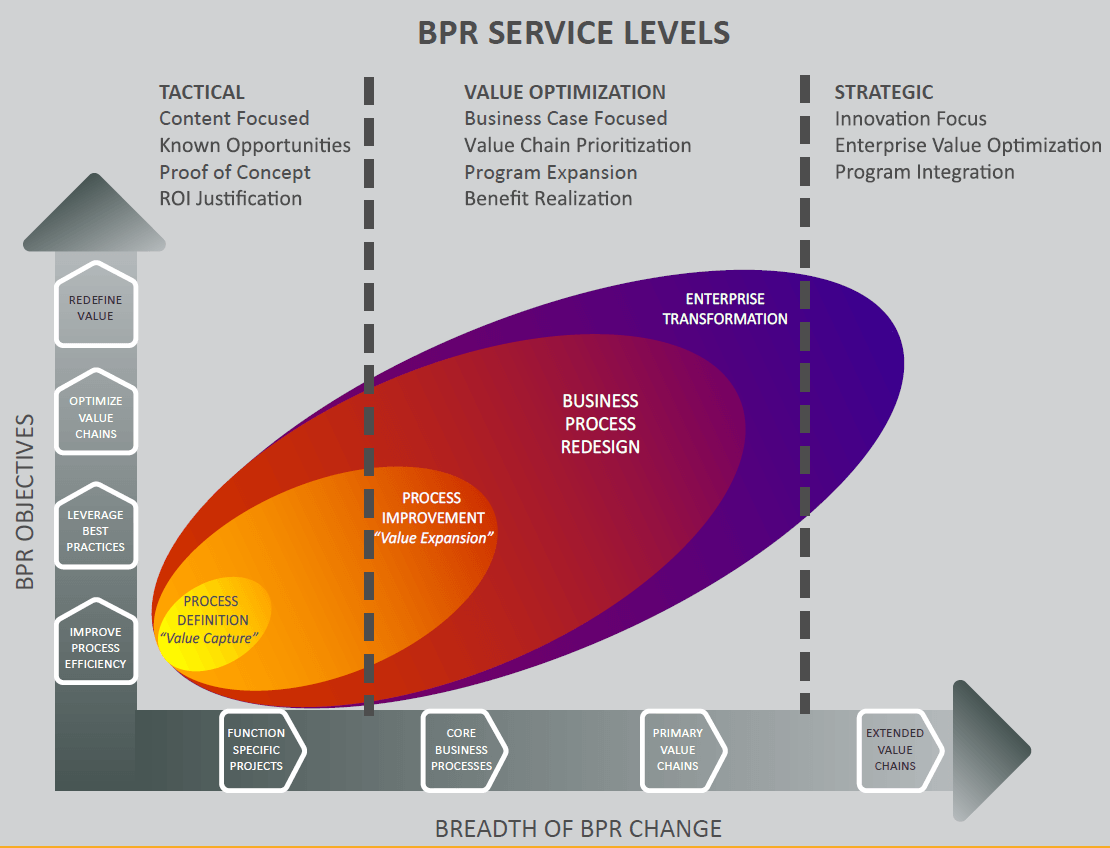The Power of BPR (Business Process Reengineering)
It can be anything from simply identifying your current process so that you know the business value it provides to your organization, to an Enterprise Transformation that redefines value and extends value chains. Many people think of Michael Hammer, W. Edwards Deming or Lean Six Sigma, while others confuse process improvement with BPR.
Although we all know that people deliver benefits, it was Williams Edwards Deming who said “85% of the reasons for failure to meet customer expectations are related to deficiencies in systems of processes…rather than the employee.” It was Michael Hammer who said, “Re-engineering Work: Don’t Automate, Obliterate”.

Most of the time, whether re-engineering or just making things more efficient, BPR involves a great deal of scoping, planning, and stakeholder management to understand the right processes to automate, re-engineer or just leave alone. Most importantly, BPR starts with carefully defining the problem. The following story illustrates this point:
An engineer, BPR manager and software developer are driving down a steep mountain road. The brakes fail and the car careens down the road out of control. Half way down, the driver manages to stop the car by running it up an embankment narrowly avoiding going over a cliff. They all get out, shaken by their narrow escape from death, but are otherwise unharmed.
The BPR manager said, “To fix this problem we need to organize a committee, have meetings, and through a process of continuous improvement, develop a solution.”
The engineer said, “No, that would take too long, and besides, that method has never worked before. I have my trusty pen knife here and will take apart the brake system, isolate the problem and correct it.”
The software engineer said, “I think you’re both wrong! I think we should all push the car back up the hill and see if it happens again!”
Essentially, BPR is a problem-solving approach and set of techniques focused on defining the problem in terms of cost and impact. While this is not unique to BPR, BPR offers a robust set of approaches, tools, techniques and potential solutions that often puts the problem in perspective and uses metrics to achieve measurable and communicable results. This is achieved most effectively by focusing on and analyzing the business functions and/or capabilities to understand the current state of operations and developing a future state that meets the needs of the ultimate customer set.
Most BPR frameworks or models follow a sequence of stages. The following figure depicts a traditional model:

There are benefits of this approach. The “To-Be Design” is strengthened not only by the BPR team’s understanding of the current business functions or capabilities, but also by the identification of critical areas of frustration and “pain” within and among those functions or capabilities. Combined with the clearer understanding of the customers’ requirements for the performance of the current business functions/capabilities and their requirements moving towards the future state, BPR produces key insights necessary for transformational change. In particular, the resulting business requirements are very detailed, and return on investment (ROI) is much easier to ascertain prior to making an investment. This approach encourages the buy-in of sponsors and key stakeholders, as well as enables effective communication with customers. This communication fosters clearer expectations across the board as to what change is going to happen, and the value that change will bring.
Expected outcomes of executing BPR include the following:
- Improved performance as measured by traditional business metrics such as quality improvement, reduced cycle times, or higher customer satisfaction
- Reduced costs based on improved performance
- Improved efficiency across business functions, teams, and organization units
- Increased effectiveness of solutions such that the mapping of the As-Is state to the future state allows the assessment of impact of change, and therefore managing change more effectively
- Development of a unique business operation focused on distinct customer segments focused on the customer
- Business growth resulting from alignment between people, processes, mission performance, and technology
Evans Incorporated’s unique application of BPR, or Business Process Improvement (BPI) as we call it, is paired with our Change Management offering, promoting the development of a collaborative solution supported by an active and visible sponsor who achieves a high level of leadership commitment. This commitment, along with heavy emphasis on consistent and structured communication to all stakeholders, and careful planning that enables capacity building, is what greatly reduces the risk that the intended ROI will be reached.
Do you want to maximize the chance of executing your strategy? Consider Evans BPI as the bridge to realizing your future.
To find out more about how Evans’ human-centered approach to Business Process Improvement can enrich you and your organization, please contact Emad Elias, PMP, CMP, CLSSGB, at eelias@evansconsulting.com.


